Layer2 is still the mainstream narrative of the crypto market this year, especially since May last year, under the stimulus of OP, Arbitrum and other token incentives, ZkSync, StarkNet, and the newly emerged Linea have received great attention. The user base of these Layer2s has exploded after going online on the mainnet or testnet.
However, using tokens to attract users is not a long-term solution. After the tokens are released, how to steadily increase TVL while maintaining attractiveness to users is a problem that Layer2s and almost all projects in the industry must face.
After all, unlike Internet apps that can deeply bind users through social relationships and user data, for the current grass-roots Web3 users, loyalty is almost irrelevant. After the tokens are distributed, it is time to really compete with strength.
So, what is the current situation of the fiercely competitive Layer2 track? What are the big killers for future evolution for each of them? Who will eventually win? Next, we will take a closer look at the top Layer2s one by one.
- Viewpoint: Interpretation of MakerDAO’s recent movements, why I am optimistic about its future trend?
- Tracking the Flow of Stolen Funds from Poly Network Hack and Revealing Hacker Techniques
- Cult of Move’s Blasphemer: The mechanical structure of this building is flawed, it just hasn’t collapsed yet.
The current situation of Layer2
The rise of the Layer2 track originated from the “impossible triangle” of Layer1 public chains, that is, the scalability, security, and decentralization of public chains cannot be simultaneously taken into account. As the super leader of the public chain track, Ethereum, in order to solve its own scalability problems, took the lead in opening up sidechains, Rollup, validium and other expansion plans. From the current development, Rollup stands out alone, and almost overshadows the wind of other expansion plans, and even Polygon, the representative of Ethereum’s sidechain, has turned to Rollup. After the Polygon ZKevm mainnet went online in late March this year, the number of user addresses and transaction volume has quickly increased. Rollup includes Optimistic Rollup and ZK Rollup, of which Arbitrum and OP are representatives of Optimistic Rollup, and Starknet, ZkSync, Scroll, and Polygon ZKEVM are the four major players of ZK Rollup. With the exception of Scroll, all these star Rollup projects have successively gone online on their mainnets. From the current TVL ranking, Arbitrum is far ahead, with a TVL share of more than 60% among all Layer2s, and is undoubtedly the leader of Layer2. OP follows closely, with a share of more than 20%. As for ZK Rollup projects, the most popular ZkSync Era TVL share is less than 7% recently, and others are even less. The share of Starknet and Polygon ZKEVM is less than 1%.
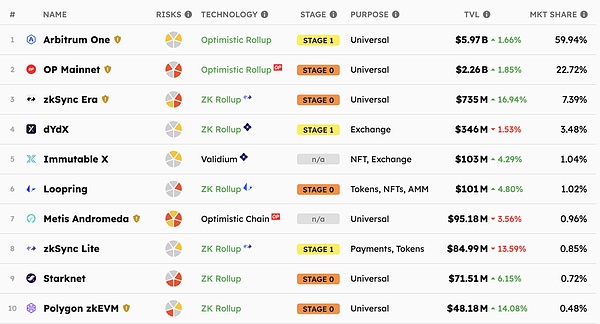
According to l2beat, the top ten Layer2 projects by TVL are shown in the image above. Of course, there are technical difficulties, and the complexity of ZK Rollup technology is indeed much higher than that of Optimistic Rollup. Therefore, both Optimistic Rollup representatives Arbitrum and OP were launched on the mainnet in 2021, and token distribution did not begin until a year later. Both have not only taken the lead, but also have enough time to attract developers or users to build ecosystems. However, in the Web3 field, both developers and users have never had too much loyalty. With the expectation of token distribution and community incentives, it is easy to switch from the original ecosystem to a new one. Since the ZkSync Era mainnet went live in March, its TVL has skyrocketed to nearly 700 million U in just three months, accounting for nearly 7% of TVL, and its weekly growth rate is over 13%. The number of official bridge-independent addresses is close to one million. This impressive data performance is due in part to the token distribution expectations of ZkSync Era, and also related to the EVM compatibility of ZkSync Era. Its high compatibility with EVM allows developers and users on Ethereum and other Optimistic Rollups to move smoothly. In contrast, although Starknet is the most popular ZK Rollup project, the performance of TVL, address numbers, and ecosystem projects seems to be lower than expected. After all, Starknet uses the independent Cario contract language, and the development cost of deploying projects will be much higher.
Future development direction of Layer2
According to the current data performance of various Layer2 projects, Optimistic Rollups such as Arbitrum and OP have taken the lead and still maintain overwhelming advantages in TVL data and ecosystems after the end of token distribution. However, temporary leadership does not mean that one can be carefree, because ZK Rollup is the long-term trend of the future. Although Optimistic Rollups such as Arbitrum and OP can also turn to embrace ZK Rollup after gaining the first-mover advantage of ecosystem construction, the technical challenges of ZK are still a hurdle that needs to be overcome. Compared with ZK Rollups such as Starknet and ZkSync, who have been working in the ZK field for many years, it is still difficult to say who can truly gain the final advantage. Moreover, if Web3 truly becomes mainstream, the biggest challenge ahead is scalability and interoperability. Firstly, the ideal TPS of Layer2 is only a few thousand, which is still unable to meet the needs of the real world. Secondly, the interaction between different chains mainly depends on cross-chain bridges, and the repeated theft of cross-chain bridges has raised the importance of interoperability to a new height. Therefore, the current top Layer2 projects are actively laying out the second half in order to stand undefeated in the long-term battle of Layer2, whether actively or passively.
(1) Arbitrum: Layer3 Strategy The Arbitrum ecosystem consists of four products, including Arbitrum One, Arbitrum Nova, Arbitrum Nitro, and Arbitrum Orbit. Arbitrum Orbit is the Layer3 framework that will be deployed in the future based on the One and Nova chains, which is Arbitrum’s vision for the evolution of Layer2.
In other words, One and Nova are two general Layer2 chains that can support many Dapp applications. However, for some applications with higher scalability requirements, such as games and derivative trading, customized L3 chains can be developed based on the Arbitrum Orbit framework.
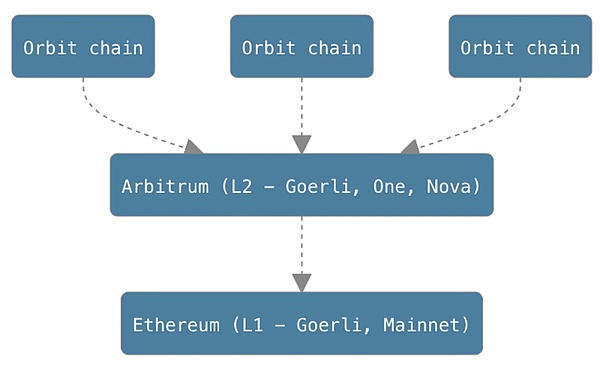
Arbitrum L3 solution diagram, source: Arbitrum website
L3 based on Arbitrum Orbit has greatly improved scalability compared to current Layer2 chains. After all, if the data of L2 is rolled up to L1 and the TPS can be increased tenfold, then the similar operation and algorithm level of L3 to L2 Rollup will also increase the TPS tenfold. Thus, the TPS improvement of L3 compared to L1 is one hundred times.
Of course, the security of L2 depends on L1, and the security of L3 depends on both L1 and L2. Therefore, compared to L2, L3 compromises somewhat in terms of security.
(2) OP: OP Stack – Super Chain
OP’s vision for the evolution of Layer2 is the OP Stack, which aims to simplify the construction of Layer2 blockchains and establish a “Layer2 supermarket” where users can freely choose the tools or modules they need to build their own Layer2 chains.
Specifically, different selectable modules are provided for each conceptual layer of Layer2. When users need to create their own Layer2, they can extract different modules from each conceptual layer according to their needs to customize their own Layer2 . For example, for the data availability layer, users can choose Ethereum or Celestia for data Rollup.
After OP Stack was announced in October last year, it quickly gained many heavyweight partners, including Binance, Coinbase, Worldcoin, Zora, etc. It can be said that OP is currently the fastest modularized pusher of L2.
In addition, on June 6th this year, OP released the first official version of OP Stack: Bedrock. After the upgrade of Bedrock, OP’s average gas fee decreased by about 77% compared to before, becoming the cheapest Ethereum Layer2 for exchanging tokens.

A list of transaction fees for various Layer2 solutions (Note: data for Metis Network is incorrect), source: l2fees
Of course, Bedrock is just the first step, and the next step for the OP Stack is Superchain, which is a multitude of OP chains built on the OP bridge, sharing security, communication layer, and OP Stack among them. These chains have atomic cross-chain composability, meaning that different OP chains can seamlessly connect without the need for any cross-chain bridge or intermediary communication, solving the interoperability pain points between chains.
Of course, this is not a one- or two-year plan, and the OP team has stated that this is a “multi-year (if not ten-year) journey.”
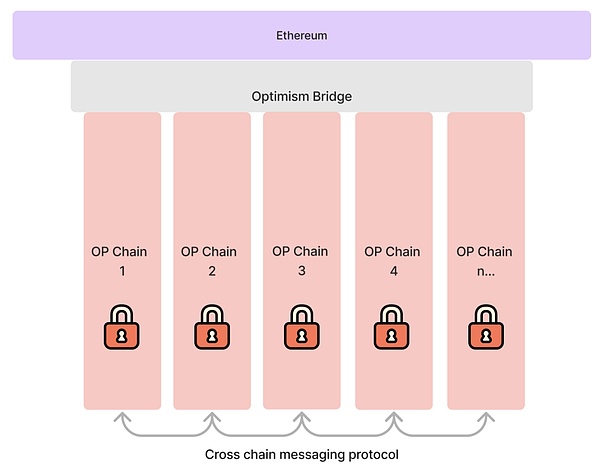
Visualization of the OP Superchain, source: OP website
(3) ZkSync: Hyperchain
ZkSync was the first ZK Rollup to go live on the mainnet, and compared with other ZK Layer2 solutions, its TVL, user address count, and ecological development growth rate are the fastest, and it seems to be moving faster when considering the future evolution of Layer2.
ZKSync’s vision for the future evolution of Layer2 is Hyperchain , and the structure of the Hyperchain looks a bit like Arbitrum L3, but the difference is quite significant.
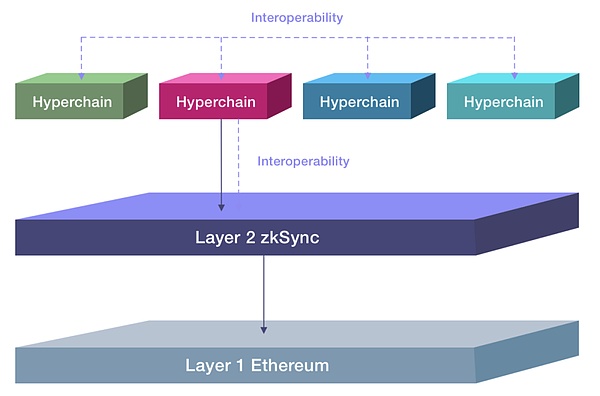
Source: zkSync official website
The Hyperchain is also implemented in a modular way, and developers can directly choose the appropriate module to customize their own Hyperchain without permission, and regardless of who deploys it, the Hyperchain can inherit security directly from the Ethereum mainnet.
Moreover, there are super bridges that interact directly between different Hyperchains, avoiding the risk of hacker attacks caused by non-local bridges and further increasing the security and interoperability of the Hyperchain.
(4) Starknet: Recursive STARKs
The team behind Starknet, StarkWare, was the first to propose a multi-layer architecture for Layer2, including using Layer2 as a general extension layer, and Layer3 for custom extension layers, etc., with similar evolution paths to the Layer2 projects mentioned above. However, in the actual operation process, Starknet has not done much about Layer2 layered evolution. In August of last year, StarkWare launched Recursive Starks, which can support multiple transaction proofs bundled into a single proof, enhancing the scalability of L2. Recursive Starks has indeed opened up new ways of thinking about the scalability of public chains, but this new technology is quite complex, and specific landing applications still need to be further observed.
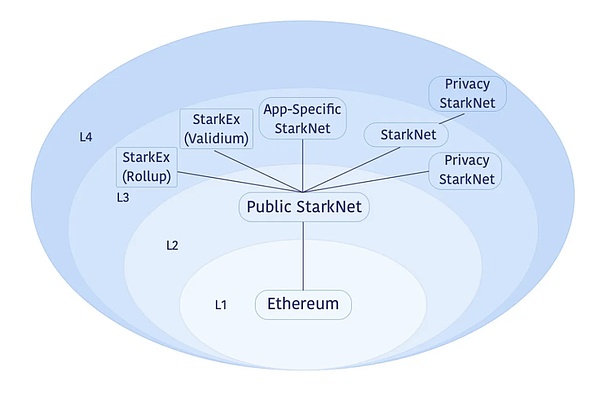
The multilayer architecture framework originally proposed by StarkWare, source: StarkWare blog
(5) Polygon: Building the Internet Value Layer
Polygon, as the flagship of Ethereum sidechains, has products including customized application chain Supernets, ZK Rollup chain Polygon zkEVM, and other products or platforms in addition to sidechains. Recently, Polygon just launched Polygon 2.0, clarifying its evolution path in the Layer2 battle, which can be summarized as “building the Internet value layer.” Specifically, all of Polygon’s products or platforms will be integrated into Polygon 2.0, with upgrades, improvements, and deletions made where necessary. In addition, the Polygon 2.0 platform can “provide unlimited scalability” in the future. Like OP’s interoperability, the interoperability layer of Polygon 2.0 can offer almost real-time atomic cross-chain transactions, greatly improving the interoperability between chains within the Polygon 2.0 ecosystem and reducing the security risks of inter-chain interactions.
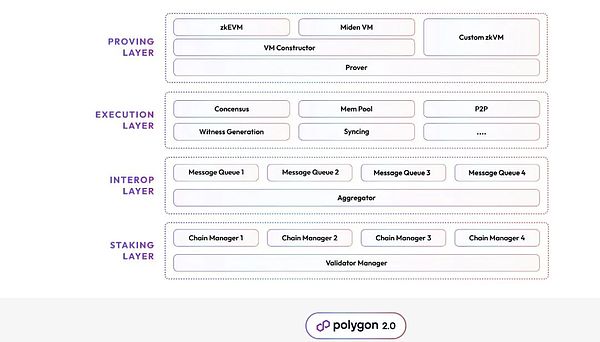
Polygon 2.0 architecture, source: Polygon official website
Summary
Overall, the advantages of these top Layer2s in the fierce competition are as follows: OP: The first Layer2 to go online, the first to have institutional cooperation to deploy Stack applications, and more and more heavyweight institutions are beginning to express partnership intentions. Arbitrum: The one with the largest TVL (60% share), with a thriving on-chain ecosystem and killer native high-quality projects such as GMX. ZKSync: The first Layer2 to land zkEVM. Starknet: Obvious technical and team advantages, although the use of Cairo language currently limits TVL growth and ecosystem development, but once it breaks through, it may bring barrier advantages. Polygon: Long development time, strong community, and multiple Layer2 directions being promoted, flexible and optional full solution, known as more decentralized ZKEVM. Which one is more advantageous? At present, it can only be said that each has its own characteristics. However, the entry of dozens of teams into the Layer2 track has indeed made the competition in this field more intense, but as a race with relatively high determinism and high ceiling, such competition may not be a bad thing. Whether it’s Arbitrum’s L3, OP’s OP Stack, ZKSync’s Hyperchain, Starknet’s recursive Starks, or Polygon 2.0, they are all working to solve the scalability and interoperability problems of public chains. In the past two rounds of bull and bear market transitions, the competition of public chains has always topped the list of topics, perhaps after Layer2s have successively landed on Ethereum and the general scalability needs are no longer a big problem, the Layer2 battle will be the real focus of the future.
Like what you're reading? Subscribe to our top stories.
We will continue to update Gambling Chain; if you have any questions or suggestions, please contact us!